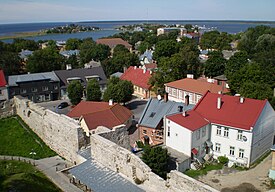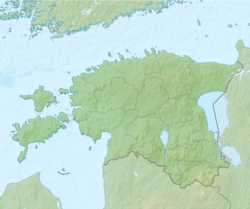Haapsalu
Haapsalu | |
|---|---|
 View from Haapsalu Castle | |
Location within Baltic Sea region | |
| Coordinates: 58°56′22″N 23°32′27″E / 58.93944°N 23.54083°E | |
| Country | |
| County | |
| Municipality | |
| Town rights | 1279 |
| Area | |
| • Total | 11.09 km2 (4.28 sq mi) |
| Elevation | 10 m (30 ft) |
| Population (2020)[1] | |
| • Total | 9,375 |
| • Rank | 14th |
| • Density | 850/km2 (2,200/sq mi) |
| Ethnicity (2021) | |
| • Estonians | 83.5% |
| • Russians | 11.9% |
| • other | 4.6% |
| Time zone | UTC+2 (EET) |
| • Summer (DST) | UTC+3 (EEST) |
| Postal code | 90503 to 90507 |
| Area code | (+372) 047 |
| Vehicle registration | S |
Haapsalu (Estonian pronunciation: [ˈhɑːpsɑlu]) is a seaside resort town located on the west coast of Estonia. It is the administrative centre of Lääne County, and on 1 January 2020 it had a population of 9,375.[1]
History
[edit]The name "Haapsalu" derives from the Estonian words haab 'aspen' and salu (archaic meaning) 'island'.[2] Until the first half of the 20th century, in Swedish and German the town was called Hapsal. Haapsalu and the surrounding area was the center for the Estonian Swedes from the 13th century until the evacuation of almost all ethnic Swedes from Estonia prior to the Soviet invasion of Estonia during World War II in 1944.[citation needed]
The first written record of Hapsal dates back to 1279, when the town was chartered and became the capital of the Bishopric of Ösel-Wiek, which it remained for the following three centuries. Buildings from those early days remain today, including an episcopal castle which has the largest single-nave church in Estonia.[citation needed]
Neighborhoods of Haapsalu
[edit]There are six neighborhoods of Haapsalu:
- Holmi
- Kesklinn
- Männiku
- Paralepa
- Randsalu
- Vanalinn.[3]
Healing by sea mud
[edit]The sea mud in Haapsalu is claimed to have a curative effect. A military doctor, Carl Abraham Hunnius, founded the first mud cure resort in 1825. News of the "curative mud" spread quickly amongst the wealthy customers in then capital city Saint Petersburg, and elsewhere in the former Russian Empire. The mud spas were frequented by the Russian imperial Romanov family.[4] For almost 200 years, Haapsalu has been a popular summer destination where people from all around the world come for medical treatment. At present, there are three "mud cure" establishments in Haapsalu.
Other attractions
[edit]The Land of Ilon Wikland (Wiklandia), a recreation centre for children, is set to open in a few years[when?] within the town. Wikland, a famous book illustrator, has had a strong bond with Haapsalu since her childhood.
The August Blues Festival is held every year in August in Haapsalu.
Since 2005, the town hosts Haapsalu Horror and Fantasy Film Festival, an annual film festival dedicated to genre films.[5] In 2017, the pastors of Haapsalu made an open statement calling to end the city's financing of the festival, claiming the horror and violence depicted in the screened films were not fit to represent the resort town image.[6] The same year the festival was held to a record-breaking attendance.[7]
Demographics
[edit]| Ethnicity | 1922[8] | 1934[9] | 1941[10] | 1959[11] | 1970[12] | 1979[13] | 1989[13] | 2000[14] | 2011[15] | 2021[16] | ||||||||||
|---|---|---|---|---|---|---|---|---|---|---|---|---|---|---|---|---|---|---|---|---|
| amount | % | amount | % | amount | % | amount | % | amount | % | amount | % | amount | % | amount | % | amount | % | amount | % | |
| Estonians | 3597 | 84.9 | 4103 | 88.3 | 3580 | 94.5 | 6819 | 79.6 | 8417 | 73.3 | 9058 | 69.5 | 9704 | 66.4 | 9587 | 79.5 | 8404 | 82.0 | 8016 | 83.5 |
| Russians | 178 | 4.20 | 125 | 2.69 | 57 | 1.50 | - | - | 2220 | 19.3 | 2987 | 22.9 | 3726 | 25.5 | 1841 | 15.3 | 1427 | 13.9 | 1140 | 11.9 |
| Ukrainians | - | - | 0 | 0.00 | - | - | - | - | 296 | 2.58 | 441 | 3.38 | 547 | 3.74 | 287 | 2.38 | 181 | 1.77 | 127 | 1.32 |
| Belarusians | - | - | - | - | - | - | - | - | 99 | 0.86 | 186 | 1.43 | 233 | 1.59 | 97 | 0.80 | 61 | 0.60 | 58 | 0.60 |
| Finns | - | - | 5 | 0.11 | 6 | 0.16 | - | - | 62 | 0.54 | 81 | 0.62 | 77 | 0.53 | 64 | 0.53 | 57 | 0.56 | 60 | 0.63 |
| Jews | 9 | 0.21 | 5 | 0.11 | 0 | 0.00 | - | - | 23 | 0.20 | 20 | 0.15 | 12 | 0.08 | 5 | 0.04 | 4 | 0.04 | 3 | 0.03 |
| Latvians | - | - | 10 | 0.22 | 3 | 0.08 | - | - | 44 | 0.38 | 40 | 0.31 | 32 | 0.22 | 9 | 0.07 | 12 | 0.12 | 15 | 0.16 |
| Germans | 304 | 7.17 | 251 | 5.40 | - | - | - | - | - | - | 46 | 0.35 | 48 | 0.33 | 16 | 0.13 | 8 | 0.08 | 6 | 0.06 |
| Tatars | - | - | 0 | 0.00 | - | - | - | - | - | - | 38 | 0.29 | 38 | 0.26 | 15 | 0.12 | 10 | 0.10 | 11 | 0.11 |
| Poles | - | - | 11 | 0.24 | 11 | 0.29 | - | - | - | - | 21 | 0.16 | 18 | 0.12 | 9 | 0.07 | 4 | 0.04 | 7 | 0.07 |
| Lithuanians | - | - | 0 | 0.00 | 1 | 0.03 | - | - | 26 | 0.23 | 24 | 0.18 | 27 | 0.18 | 24 | 0.20 | 18 | 0.18 | 15 | 0.16 |
| unknown | 0 | 0.00 | 1 | 0.02 | 0 | 0.00 | 0 | 0.00 | 0 | 0.00 | 0 | 0.00 | 0 | 0.00 | 34 | 0.28 | 13 | 0.13 | 37 | 0.39 |
| other | 149 | 3.52 | 138 | 2.97 | 131 | 3.46 | 1748 | 20.4 | 296 | 2.58 | 93 | 0.71 | 155 | 1.06 | 66 | 0.55 | 52 | 0.51 | 101 | 1.05 |
| Total | 4237 | 100 | 4649 | 100 | 3789 | 100 | 8567 | 100 | 11483 | 100 | 13035 | 100 | 14617 | 100 | 12054 | 100 | 10251 | 100 | 9595 | 100.01 |
In popular culture
[edit]Pyotr Ilyich Tchaikovsky in 1867 wrote a suite of three pieces for piano during his stay in Haapsalu, titled Souvenir de Hapsal.
In the 19th century, the town became famous for its "Haapsalu shawls", a delicate craft made by local women.
Haapsalu has sometimes been called the "Venice of the Baltics" — an apparent exaggeration used mostly to promote the resort town to foreign tourists.[17]
Haapsalu is site of a fencing school founded by Estonian fencer Endel Nelis, used as the setting of the Finnish-Estonian film The Fencer.[18]
Gallery
[edit]-
Haapsalu castle
-
Central square
-
Town centre
-
Haapsalu kuursaal (resort hall)
-
Bay of Haapsalu Tagalaht
-
Former train station, notable for the length of its platform canopy.
-
Town Hall
-
Train station
-
Orthodox Church of St. Mary Magdalene
-
A pavilion by the seaside promenade
-
View from the promenade
-
Jaani Lutheran church
See also
[edit]References
[edit]- ^ a b c "Population number, area and density. administrative division as at 01.01.2018". Statistics Estonia. Retrieved 1 June 2020.
- ^ Eesti kohanimeraamat (Dictionary of Estonian Place names). Institute of the Estonian Language. 2016.
- ^ "LINNAOSADE JA -JAGUDE LÜHENDID". www.eki.ee (in Estonian). Retrieved 18 March 2020.
- ^ Dallen J. Timothy (18 May 2009). Cultural heritage and tourism in the developing world: a regional perspective. Taylor & Francis. pp. 239–. ISBN 978-0-415-77621-9. Retrieved 17 January 2012.
- ^ Thomas M. Sipos (2012). Horror Film Festivals and Awards. McFarland. ISBN 9780786465729
- ^ "Haapsalu pastorid tegid pöördumise HÕFFi vastu - Lääne Elu". le.ee. 23 March 2017. Retrieved 13 April 2018.
- ^ "HÖFF tõi rekordi". postimees.ee. Retrieved 13 April 2018.
- ^ 1922 a. üldrahvalugemise andmed. Vihk I ja II, Rahva demograafiline koosseis ja korteriolud Eestis (in Estonian and French). Tallinn: Riigi Statistika Keskbüroo. 1924. p. 33. ISBN 9789916103067.
- ^ Rahvastiku koostis ja korteriolud. 1.III 1934 rahvaloenduse andmed. Vihk II (in Estonian and French). Tallinn: Riigi Statistika Keskbüroo. 1935. pp. 47–53. hdl:10062/4439.
- ^ Eesti Statistika : kuukiri 1942-03/04 (in German and Estonian). Tallinn: Riigi Statistika Keskbüroo. 1942. pp. 66–67.
- ^ Katus, Kalev; Puur, Allan; Põldma, Asta (2002). Rahvastiku ühtlusarvutatud sündmus- ja loendusstatistika: Läänemaa 1965-1990. Sari C (in Estonian and English). Tallinn: Eesti Kõrgkoolidevaheline Demouuringute Keskus. pp. 31–32. ISBN 9985820703.
- ^ Население районов, городов и поселков городского типа Эстонской ССР : по данным Всесоюзной переписи населения на 15 января 1970 года (in Russian). Tallinn: Eesti NSV Statistika Keskvalitsus. 1972. p. 79.
- ^ a b Eesti Vabariigi maakondade, linnade ja alevite rahvastik. 1. osa, Rahvaarv rahvuse, perekonnaseisu, hariduse ja elatusallikate järgi : 1989. a. rahvaloenduse andmed (in Estonian). Tallinn: Eesti Vabariigi Riiklik Statistikaamet. 1990. pp. 28, 33. ISBN 978-9949-7193-2-7 – via Digar.
- ^ "RL222: RAHVASTIK ELUKOHA JA RAHVUSE JÄRGI". Estonian Statistical Database (in Estonian).
- ^ "RL0429: RAHVASTIK RAHVUSE, SOO, VANUSERÜHMA JA ELUKOHA JÄRGI, 31. DETSEMBER 2011". Estonian Statistical Database. Retrieved 4 February 2021.
- ^ "RL21429: Rahvastik Rahvuse, Soo, Vanuserühma Ja ELukoha (Haldusüksus) Järgi, 31. DETSEMBER 2021". Estonian Statistical Database (in Estonian).
- ^ Derek R. Hall; Melanie K. Smith; Barbara Marciszewska (30 November 2006). Tourism in the new Europe: the challenges and opportunities of EU enlargement. CABI. pp. 264–. ISBN 978-1-84593-117-9. Retrieved 17 January 2012.
- ^ Reiljan, Kaire (16 March 2015). ""Vehkleja". Kaks lugu, elu ja tõde filmis" ["The Fencer". Two stories, life and truth in film] (in Estonian). Lääne Elu. Retrieved 9 January 2016.
External links
[edit]- Haapsalu (urban municipality)
- Haapsalu
- Cities and towns in Estonia
- Populated places in Lääne County
- Populated coastal places in Estonia
- Spa towns in Estonia
- Populated places established in the 13th century
- 1279 establishments in Europe
- 13th-century establishments in Estonia
- Kreis Wiek
- Port cities and towns in Estonia














